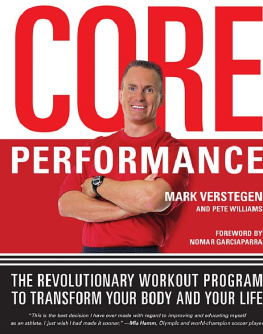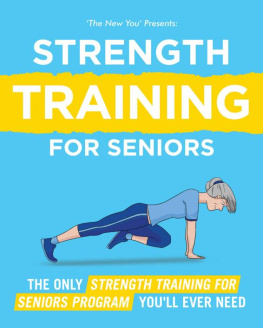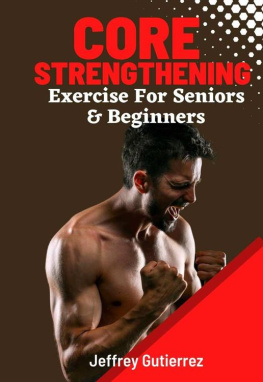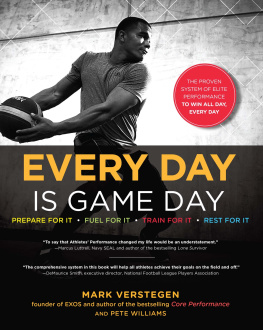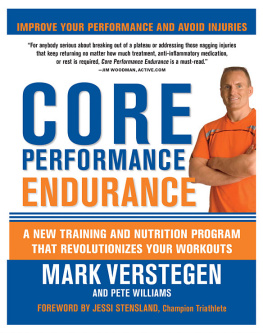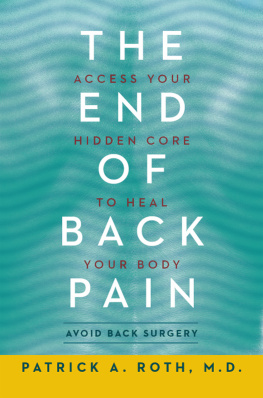MARK VERSTEGEN is recognized as one of the worlds most innovative sports-performance experts. As the owner of Athletes Performancecutting-edge training centers in Tempe, Arizona, and Carson, Californiahe directs a 25-person team of performance specialists and nutritionists to train some of the biggest names in sports, including soccer star Mia Hamm; baseballs Nomar Garciaparra, Roberto Alomar, and Vernon Wells; WTA tennis players Meghann Shaughnessy and Mary Pierce; golfers Jim Carter and Billy Mayfair; NFL veteran Trace Armstrong; hockey goalie Nikolai Khabibulin; and NBA forward Rick Fox.
By teaching an integrated lifestyle and training program that blends strength, speed, flexibility, joint and core stability, explosion, elasticity, and mental toughness, Verstegen helps athletes become not only faster and stronger but also more powerful, flexible, and resistant to injury and long-term back, hip, and other joint problems.
Verstegen has helped dozens of football players improve their NFL draft stock through his training methods; the group includes first-rounders Kyle Turley, Leonard Davis, Levi Jones, Nick Barnett, Jordan Gross, and Kwame Harris.
Because of his cutting-edge techniques and up-to-date knowledge of sports performance, Verstegen is a sought-after consultant. He serves as director of performance for the NFL Players Association, is an advisor to Adidas, and serves as a consultant to numerous athletic governing bodies, including the U.S. Tennis Association.
A dynamic speaker, Verstegen travels the world to address groups such as the American College of Sports Medicine, the National Strength and Conditioning Association, and many corporate events.
Verstegen and his training methods have been profiled in dozens of publications, including Sports Illustrated, USA Today, Smithsonian, The Sporting News, ESPN: The Magazine, USA Today Baseball Weekly, Street and Smiths SportsBusiness Journal, Robb Report, Outside, Mens Journal, Golf Digest, and Scientific American.
Verstegen was a walk-on linebacker at Washington State University who turned to performance coaching after a career-ending neck injury. After earning a bachelors degree in exercise science from WSU and a masters degree in sports science from the University of Idaho, he became the assistant director of player development at Georgia Tech. In 1994, he created the International Performance Institute on the campus of the IMG Sports Academy in Bradenton, Florida, and was quickly recognized as an innovator in sports performance. In 1999, he moved to Phoenix to build Athletes Performance, a world-class, independent training facility. The 30,000- square-foot complex recently was honored as the facility of merit by Athletic Business magazine for its design.
Verstegen and his wife Amy, a former Washington State soccer player, live in Scottsdale, Arizona.
PETE WILLIAMS is a contributing writer to Street & Smiths SportsBusiness Journal and USA Today Sports Weekly. He has written about fitness and performance for numerous publications, including Muscular Development and Mind and Muscle Power, and is the author of two books on the sports-memorabilia business: Card Sharks and Sports Memorabilia for Dummies. A graduate of the University of Virginia, he lives in Florida with his wife, Suzy, and son, Luke.
O ver the past decade, Ive helped people from all walks of life perform betternot just in sports but also in their daily lives. Ive shown them a program that not only helps them look fitter, it serves as a lifelong formula to maximize performance and help maintain a high quality of life well into their senior years.
You might believe youre already benefiting from a program of diet and exercise. Im sure you are, to some degree. After all, youve taken the biggest step by committing to better health, and that alone is empowering. But if theres one common denominator Ive seen in kids, seniors, working adultseven professional athletesits that they do not work out properly, or at least as efficiently as they could. Because of the misinformation theyve been fed by the media and marketers, they reap only a fraction of the reward and leave themselves vulnerable to physical ailments down the road.
Take my coauthor, Pete Williams. Pete looks as if hes in decent shape for a guy in his midthirties. He played sports in high school, and now, as a working adult and father, he lifts weights or runs 4 days a week. But he always has been frustrated by his inability to generate much power, whether it be hitting a baseball or performing martial-arts routines. Despite countless golf lessons, he has found that he cannot get any lift on a ball off the tee.
I asked Pete if he had any physical ailments, and, not surprisingly, he mentioned that his back tightens up while driving. Hes constantly squirming in the seat. On long rides, he has to get out and stretch after just an hour.
Not long after he arrived at Athletes Performance, the cutting-edge training center I own and operate in Tempe, Arizona, I had him hop up on a padded table and lie on his back. I asked him to raise his left leg as high as he could, and he struggled to lift it 45 degrees. I had him put the leg down and then extend it to his left. It barely moved.
Ive seen elderly and obese people perform better. By now, some of our interns had gathered around, marveling at this utter lack of flexibility. Professional tennis player Mary Pierce, who happened to be getting stretched and massaged at the next table, casually pulled a leg back so that her toe touched her shoulder.
There you have it, Pete said, nodding toward Mary. The difference between a professional athlete and a sportswriter.
Wrong! I shouted. I grabbed a rope, wrapped it around Petes foot, and had him perform the same stretches, this time raising his leg up on his own, then moving it farther by gently assisting with the rope for 2 seconds while exhaling at the end of the stretch. I helped him push at the end, and after just 10 challenging minutes, Pete was able to lift each of his legs nearly 90 degrees.

